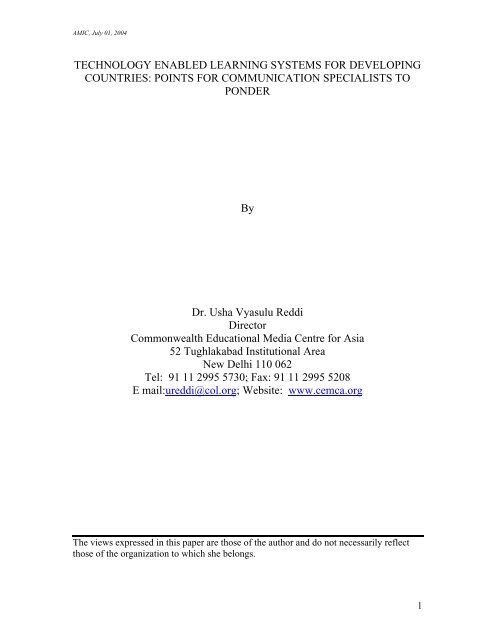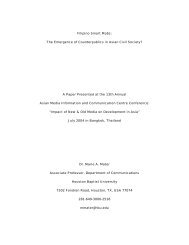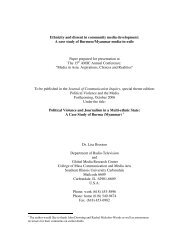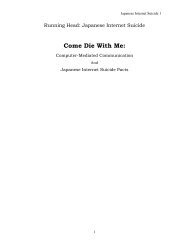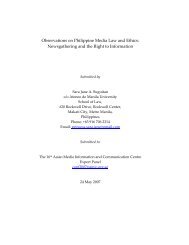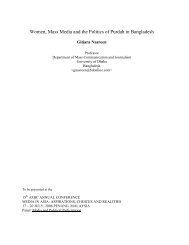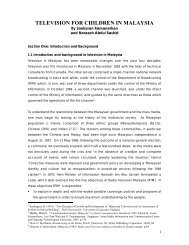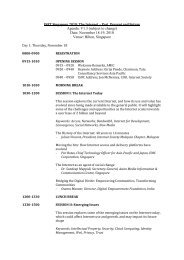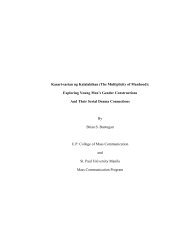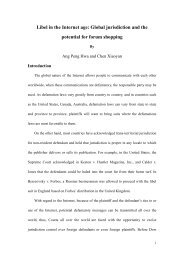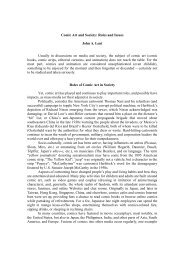technology enabled learning systems for developing countries - AMIC
technology enabled learning systems for developing countries - AMIC
technology enabled learning systems for developing countries - AMIC
Create successful ePaper yourself
Turn your PDF publications into a flip-book with our unique Google optimized e-Paper software.
<strong>AMIC</strong>, July 01, 2004TECHNOLOGY ENABLED LEARNING SYSTEMS FOR DEVELOPINGCOUNTRIES: POINTS FOR COMMUNICATION SPECIALISTS TOPONDERByDr. Usha Vyasulu ReddiDirectorCommonwealth Educational Media Centre <strong>for</strong> Asia52 Tughlakabad Institutional AreaNew Delhi 110 062Tel: 91 11 2995 5730; Fax: 91 11 2995 5208E mail:ureddi@col.org; Website: www.cemca.orgThe views expressed in this paper are those of the author and do not necessarily reflectthose of the organization to which she belongs.1
<strong>AMIC</strong>, July 01, 2004TECHNOLOGY ENABLED LEARNING SYSTEMS FOR DEVELOPINGCOUNTRIES: POINTS FOR COMMUNICATION SPECIALISTS TOPONDERByDr. Usha Vyasulu ReddiDirectorCommonwealth Educational Media Centre <strong>for</strong> Asia52 Tughlakabad Institutional AreaNew Delhi 110 062Tel: 91 11 2995 5730; Fax: 91 11 2995 5208E mail:ureddi@col.org; Website: www.cemca.orgI. IntroductionWhich is more important, communication or education? Let us accept, at the outset, thatboth are related phenomena and cross paths at a field called educational communication, andinclude the concepts of <strong>for</strong>mal structured <strong>learning</strong>, and in<strong>for</strong>mal unstructured <strong>learning</strong>through many and varied communication channels.Educational communications—that is what educational <strong>technology</strong>, I believe, is all about.It was with this simple and naïve understanding of the field that I approached theestablishment and administration of an educational media centre. From my perspectiveas a teacher of communication, I looked at this field as one that should be the monopolyof media experts, and I thought, back in 1984, that it would be a simple one-two-threetask to set up and run such a centre.And what were my credentials? Degrees in mass communication, teaching and researchexperience in a university and head-ship of one of the best departments ofcommunication and journalism in India. Enough, I thought, to run the show.My illusion of simplicity was quickly shattered and I learned that the practice ofeducational communication was far removed from any theory which I may have learnedor taught. And as I learned through trial and error, through excitement and anguish,through motivation and frustration, I found that this is a field in which no two days arealike, and one which calls on all the senses, all the alertness and creativity I couldcommand from myself and my colleagues. And so today, twenty years later, I do notpresume to know all the problems, all the answers, or all the situations, but would like toshare what little I do know.2
<strong>AMIC</strong>, July 01, 2004II.The technologiesThe new technologies of communication--from the individualized computer assisted<strong>learning</strong> <strong>systems</strong> to the more mass directed radio and television today offer an unparalledopportunity to reconsider conventional educational practices and institutions. The notionthat teaching and <strong>learning</strong> can be taken out of the confines of existing schools and colleges,that teaching can be individualized and insensitive to geoclimatic distances is one which hasemerged out of the telecommunications revolution sweeping across the world in the 1980sand 1990s.The technological opportunities that the telecommunications revolution offered ranged frominnovations in traditional media such as print, radio and television to the more recentInternet, World Wide Web. Today, it is e <strong>learning</strong> and the “potential” that this <strong>for</strong>m ofeducation has <strong>for</strong> revolutionizing the way we transact education.Factors have helped promote e <strong>learning</strong> as the new paradigm in <strong>learning</strong> include on theone hand, the technological capacity to do so; and on the other, liberalization,privatization, and globalization as economic and social realities that are moving the worldinto a new system of interdependence of <strong>systems</strong> and protocols. Education has beenidentified as one of the 12 main services, which to be opened up <strong>for</strong> free flow of tradebetween <strong>countries</strong>. The <strong>for</strong>m of this flow will become clear only in April 2005 whenGATS comes into full <strong>for</strong>ce after rounds of negotiations among participating <strong>countries</strong>.Then, more than now, knowledge will become a tradable commodity; and it will makebusiness sense to move into the field of e <strong>learning</strong>.E <strong>learning</strong> has now become a catch-all phrase <strong>for</strong> all <strong>for</strong>ms of electronic <strong>learning</strong> andthere is confusion all around in understanding the concept. Some call a website or aportal a virtual <strong>learning</strong> plat<strong>for</strong>m. Others call any e-mail transacted <strong>learning</strong> as e<strong>learning</strong>. Still others confuse multimedia and streaming video <strong>for</strong> e <strong>learning</strong>.Technology <strong>enabled</strong> education is an umbrella term which includes all <strong>for</strong>ms ofeducational transactions mediated by electronic means, whether it is a website, Internetradio, audio and streaming video, etc. E <strong>learning</strong> is one such <strong>for</strong>m. There are manydefinitions of <strong>technology</strong> <strong>enabled</strong> <strong>learning</strong>, or e <strong>learning</strong>. The term e <strong>learning</strong> itself refersto a wide range of IT related activities, and is used interchangeably with terms such asdistance education; web based education; computer based training; virtual education, online <strong>learning</strong>, to cite a few. While many definitions of this term may be found bybrowsing the site www.eLearners.com and other similar sites, we are essentially referringto a paradigm of education that uses in<strong>for</strong>mation and communication technologies. E<strong>learning</strong> provides a cyber space where teachers and learners can interact across time andspace whenever and from wherever they want.III.Similarities and DifferencesIt is argued that e <strong>learning</strong> is a new paradigm of <strong>learning</strong>, different from any other in thepat. To some extent, yes, itt is a new paradigm of <strong>learning</strong>, with its own grammar,3
<strong>AMIC</strong>, July 01, 2004pedagogy and practices. It cannot be a piecemeal approach, with a bit here and a bitthere. Nor is it an end-to-end solution to the problems of education. However, it is mycontention that current <strong>technology</strong> <strong>enabled</strong> <strong>systems</strong> are very similar to the moretraditional radio and television that have been extensively used, especially <strong>for</strong> basic andnon <strong>for</strong>mal education ever since radio came on the scene.• Both <strong>systems</strong> used content produced <strong>for</strong> and distributed through mass distributionmedia; yet address the individual.• Both <strong>systems</strong>, to be successful, have to meet their audience/learner needs andstyles as closely as possible.• Both <strong>systems</strong> address distant and invisible learners.• Neither system has immediate response built in (as in interpersonalcommunication) although protagonists of e <strong>learning</strong> will have you believe thatinteractivity substitutes <strong>for</strong> such immediate response.• Both <strong>systems</strong> survive on audience/learner support and response.• Content is king is both <strong>systems</strong>.• The product of both <strong>systems</strong> is in<strong>for</strong>mation and knowledge, intangibles and wherethere is constant tussle between the market and the social good.• Both <strong>systems</strong> are closer to an industry, rather than to a service.• Both <strong>systems</strong> require innovative and flexible <strong>systems</strong> of work and management.• Both <strong>systems</strong> develop products and services, not as individuals but as teams.• Both <strong>systems</strong> require skilled manpower with specialized skills• Both <strong>systems</strong> have high start up and operational costs; while delivery costs maybe low.• Both <strong>systems</strong> enjoy public attention and are there<strong>for</strong>e subject to public debate,scrutiny and criticism.But there are differences between the traditional and the new <strong>systems</strong> being deployed <strong>for</strong>education.• Each, education and media, has its defined role in society; and while somefunctions of each sector overlap; they are often at odds with each other.• Today’s e <strong>learning</strong> initiatives are embedded in the educational process and arethere<strong>for</strong>e created in educational institutions.• Today’s e <strong>learning</strong> initiatives emerge out of a educational imperative.• Technology <strong>enabled</strong> <strong>learning</strong> <strong>systems</strong> have to add value to the <strong>learning</strong> processand results need to be visible <strong>for</strong> e <strong>learning</strong> to sustain itself• Meeting instructional objectives is more important than broad knowledge gainsas emerge from traditional educational media applications• In today’s e <strong>learning</strong>, substance takes precedence over production styles• Educational <strong>systems</strong> aim to provide relevance and quality to educational content;to achieve certain minimum standards of education and training; haveadministrative <strong>systems</strong> that enrol and instruct learners; and usually requirelearners to sit <strong>for</strong> examinations be<strong>for</strong>e receiving certification4
<strong>AMIC</strong>, July 01, 2004• Technology <strong>enabled</strong> <strong>learning</strong> <strong>systems</strong> are highly dependent on learner supportthrough tutors and part time counsellors to help learners bridge the distance gap.• Renewed research into the cognitive theories of <strong>learning</strong>, especially to determinehow <strong>learning</strong> from <strong>technology</strong> takes place, as emerged as a part of the newdiscipline of instructional design.Let me also say what e <strong>learning</strong> is not. E <strong>learning</strong> is not about merely creating a website.It is not about making content available on the Internet. It is not about putting page afterpage of text on the website. And it is not about making money.IV.Types of E <strong>learning</strong> InitiativesE <strong>learning</strong> has grown out of three different kinds of institutions. It has been developedfrom within educational institutions, which have historically offered open and distance<strong>learning</strong> opportunities either in a single, dual, or mixed mode way. A second directionhas been the growth of e <strong>learning</strong> from conventional institutions that have never beeninvolved in open and/or distance <strong>learning</strong>. Finally, the corporate sector has been quick tosee the benefit of e <strong>learning</strong> <strong>for</strong> staff training and development in its continuous search<strong>for</strong> flexible and ‘just in time” <strong>learning</strong> opportunities.There are different kinds of <strong>systems</strong> that exist and that can be set up. A first kind wouldbe single mode, where the institution decides to go it alone. This is a vertical integrationof all functions in house, from planning, course development, material development,<strong>technology</strong> and delivery mechanisms, and learner support services.There are several examples of single mode initiatives. Jones International University,www.jonesinternational.edu is the first fully accredited online university. In 1995, JonesInternational University (JIU) was launched, throwing open the doors of highereducation. Harnessing the power of the Internet, JIU was the first Web-based universityto exist entirely online.The University of Phoenix on line <strong>learning</strong> initiative is another such university wheresome of the courses are available on line. The University of Phoenix on line programme,available at www.uoponline.com describes the initiative of this private institution.Yet another example is The Penn State World Campus, from Pennsylvania StateUniversity, is available at www.worldcampus.psu.edu. This e <strong>learning</strong> initiative offersWorld Campus degree and credit certificate students online access to Penn State’s vastUniversity Libraries system—more than 3.7 million volumes, 31,000 serials andperiodicals, and numerous online research databases.In India, the Tamil Virtual University at www.tamilvu.org provides access to TamilEducation easily and effectively through the web to millions of Tamils all over the world.In the private sector, NetVarsity provides, at its site www.NetVarsity.com, opportunities<strong>for</strong> a global <strong>learning</strong> environment that crosses time & distance barriers. It bears mention5
<strong>AMIC</strong>, July 01, 2004at this stage that although there are more than a hundred e <strong>learning</strong> initiatives in theprivate sector in India, they are essentially export oriented, i.e. producing content <strong>for</strong>Western institutions of e <strong>learning</strong>.A second kind of a system is a partnership, where there is institutional collaborationbetween several similar organizations engaged in the same kind of work. This enablesdistribution and sharing of work, revenues, and costs. However, this kind of a systemrequires a shared vision and mission and commitment and involvement of all parties inthe process.Examples of such partnerships also abound. Western Governors University, atwww.wgu.edu is a unique institution that offers online degrees based completely oncompetencies – “your ability to demonstrate your skills and knowledge on a series ofassessments -- not on required courses.The African Virtual University, available at www.avu.org, is a <strong>developing</strong> countryinitiative. Initially funded by the World Bank, it now is an autonomous non-profitorganization working out of Nairobi <strong>for</strong> reaching adult learners in sub Saharan Africa.A third kind of system is a consortium, a loose partnership where individual institutionswork both as individual entities and also as cooperative partners in some areas. Many oftoday’s virtual universities are consortial arrangements that bring institutional reputationand excellence while retaining their individual identities.Examples of such initiatives include Cardean University at www.cardean.edu is aconsortium of several institutions such as Columbia University, Stan<strong>for</strong>d, Chicago Schoolof Business, Carnegie Mellon and the London School of Economics, endeavoring toprovide high quality education. A similar consortium is Universitas21,www.universitas21.com a global consortium of several high quality tertiary levelinstitutions. A British government backed initiative offers students around the world avirtual UK education ending in a real degree from Cambridge, York or SheffieldUniversities. Called ‘UkeU’, (www.ukeu.com) UK e-Universities Worldwide has justopened its online doors to students <strong>for</strong> specific courses.I would like to draw your attention to the underlying premises upon which the initiativesmentioned above have been built. No, it is not the altruistic goal of providing greateraccess to educational opportunities (except perhaps in the case of the African VirtualUniversity—which incidentally had to alter and modify its institutional andadministrative packages to survive). Much more, it is the opportunity to generate greaterrevenues, without parallel expenditures in infrastructure and to survive in an era ofdecreasing public support <strong>for</strong> education. Each one of the initiatives is designed as acorporation, with profit as its motive and with a definition of education as a commodity.Reaching out to the global market, especially in Asia, is one way of tapping some of thefastest growing educational markets in the world.6
<strong>AMIC</strong>, July 01, 2004V. Pre requisites <strong>for</strong> success.Let me list a few pre requisites <strong>for</strong> e <strong>learning</strong> to work and to draw your attention to thefact that such pre requisites are not unique to e <strong>learning</strong>. They are fundamental to thesuccess of the use of any <strong>technology</strong> <strong>for</strong> educational purposes. And some of you willremember that these were issues raised with television and non-broadcast technologiessuch as videocassettes, etc.• Accessibility. Access is also not the same as reach—the fact that a communitytele centre with internet access is available in a location does not mean the learnercan readily use it. Remember, access has been an issue with both radio andtelevision.• Interoperability. The <strong>learning</strong> content should work on all plat<strong>for</strong>ms, browsers andLearning Management Systems (LMS)—not just a handful of products. Thelearner should not have to procure the software in order to use the <strong>learning</strong>content. Remember the debate about different <strong>for</strong>mats and technologies—PAL,SECAM, NTSC, and non broadcast <strong>for</strong>mats such as Betamax and VHS.• Durability. Components developed in current versions of the model should workin later models without people having to redesign, recode or upgrade. Remember,the debates on the issues of one time use vs. repeated use of radio andtelevision.• Reusability. Content should be reusable, not just in use <strong>for</strong> a single course orlesson, but wherever it is needed. It should, there<strong>for</strong>e, be such that it is easier torepackage and use <strong>for</strong> different purposes and different groups without losing itsrelevance. Remember: the same debates about traditional media• Adaptability. It should be possible to adapt the <strong>learning</strong> content to different<strong>learning</strong> styles, learner skills, or preferences. Remember the debates aboutaudience sensitive materials• Af<strong>for</strong>dability. The cost of e <strong>learning</strong> should be attractive, have a comparativeadvantage to other ways of <strong>learning</strong>. They should not be prohibitive in cost.Af<strong>for</strong>dability was an issue even when talking of agricultural and healthinnovations.• Culturally appropriate. Content should be relevant and culturally appropriate <strong>for</strong>maximum benefit <strong>for</strong> learners. Not only should it be linguistically similar, butshould also be culture sensitive and carry a local flavour. Once again, the samedebatesVI.Some Lessons Learned from Current ExperiencesNot all the e <strong>learning</strong> initiatives over the past decade have succeeded. Many have failed.There could be many reasons <strong>for</strong> such failures. The absence of clear-cut goals andpurposes <strong>for</strong> which e <strong>learning</strong> was established in the first place is a significant cause <strong>for</strong>failure.Similarly, initiatives sometimes did not take into account the amount of time needed toput e <strong>learning</strong> into place successfully, either <strong>for</strong> the institution or <strong>for</strong> the learner.7
<strong>AMIC</strong>, July 01, 2004Some e <strong>learning</strong> initiatives, especially in the <strong>developing</strong> <strong>countries</strong> have not accounted <strong>for</strong>the critical issue of access to the Internet. Despite all the euphoria, the access of theaverage learner to the e <strong>learning</strong> environment is severely limited by poor teledensity,inadequate access to computer infrastructure and by the very high costs of registering <strong>for</strong>e <strong>learning</strong> courses or programmes.As important as access has been the poor quality of e <strong>learning</strong> content and learnersupports. With high drop out rates as a result, e <strong>learning</strong> initiatives have sometimesfailed even be<strong>for</strong>e they could take off.Equally important are the issues of funding models. And in e <strong>learning</strong>, there are nofunding or business models that one can look toward <strong>for</strong> guidance. What we do know isthat <strong>developing</strong> good e <strong>learning</strong> programmes means a high investment withoutnecessarily the consequent intake of revenue. And unless costs can be recovered, e<strong>learning</strong> initiatives can easily fail.These are some of the causes <strong>for</strong> failure. Many more could be identified from a moredetailed analysis of current initiatives.VI.Myths about E <strong>learning</strong>.Like all <strong>technology</strong> related initiatives in education, e <strong>learning</strong> is steeped inmisconceptions. Though a rapidly growing young field, aggressive marketing by ITprotagonists and vendors (with the promises of low costs and high returns) have led tointense public interests. To determine its effectiveness, educationists have tended to lookat e <strong>learning</strong> from the experience of a conventional educational system without realizingthat new technologies bring with them new paradigms of <strong>learning</strong> and management. Iwould briefly like to explore some of these misconceptions about e <strong>learning</strong> that are infree circulation and have been highlighted by Insung Jung i• There is substantial knowledge base and loads of experts in the e <strong>learning</strong>field. Quite the contrary. There is little knowledge backed by theoreticalunderstanding. In a field as young as ten years, we are just beginning to buildon the knowledge base and develop theoretical framework• Web <strong>enabled</strong> <strong>learning</strong> management <strong>systems</strong> are easy to integrate. In actualfact, this is the hardest to achieve, since there is just no clear understanding ofan approach to organizational change and also because organizational changeis the hardest to bring about.• Loads of Web <strong>enabled</strong> content exists, and it works on all LMS <strong>systems</strong>. Inactual fact, there is little existing content that has interoperability betweendifferent LMS <strong>systems</strong> and plat<strong>for</strong>ms• Traditional instructional strategies will not work online. We just don’tknow enough. And we still are unsure of the factors influencing the successof e <strong>learning</strong>.8
<strong>AMIC</strong>, July 01, 2004• Most adults enjoy looking at the hourglass waiting <strong>for</strong> downloads ofmeaningless video clips. In actual fact, most of existing e <strong>learning</strong> content iswhat learners do not need to know.• Adults like <strong>learning</strong> on a computer, particularly when their navigation skillsare challenged. On the contrary, adults feel threatened when their limitednavigational skills are exposed. They don’t finish courses because they can’tnavigate. E <strong>learning</strong> is difficult.• Employees love to learn on their own time. Quite the opposite.• E <strong>learning</strong> enables institutions to increase their market share and income.No, on the contrary, e <strong>learning</strong> is an expensive proposition, with high start upand operational costs. E <strong>learning</strong> <strong>systems</strong> are not “cash cows” <strong>for</strong> institutionsto exploit; nor are they blanket solutions to complex educational problems.And so on. The number of misconceptions is many. I have drawn attention to just a few.VII.A Communication PerspectiveBy this time, you are probably all wondering what I am trying to say and where I amleading you.I begin with the premise that <strong>technology</strong> <strong>enabled</strong> <strong>learning</strong> <strong>systems</strong> are an extension, ornewer ways of describing the role of media in education. I also argued that e <strong>learning</strong> isemerging as a new paradigm of <strong>learning</strong> and teaching.To me, as a person working with communication <strong>for</strong> a long time and with backgrounds inpsychology and political science, it seems that today’s technologies of software plat<strong>for</strong>msor content development are a natural progression of the way in which we first developedgood writing <strong>for</strong> media; went on to write and develop audio and video scripts andprogrammes, and learnt to integrate narration, sound effects, and text in <strong>developing</strong>media content and products. We have now added the computer and telecommunicationdimensions to the development of content. And when we integrate new media ofdelivery, we add a new grammar, perhaps a new paradigm, but what we know about therole and position of media in development of societies has not changed much.E <strong>learning</strong> is the flavour of the season and I am trying to draw your attention away fromthe euphoria of e <strong>learning</strong> bandwagon as a “one size fits all” solution to the problems ofeducation. I am trying to draw your attention to the body of research on media that hasbeen built up over the years in the 20 th century and which is equally applicable <strong>for</strong> thenew media today.And what do the research findings say? To the proposition that <strong>technology</strong> <strong>enabled</strong> <strong>systems</strong>enhance <strong>learning</strong> outcomes; I draw your attention to long standing findings that there are noundifferentiated gains from using media. Learning does take place but it is not thestructured <strong>learning</strong> of a classroom or textbook Even when structured <strong>learning</strong> takes place, itis when and where the content of any medium is closely matched to the learner needs, stylesand daily life, and integrated into the entire educational process. It is when issues of access,9
<strong>AMIC</strong>, July 01, 2004af<strong>for</strong>dability, ease of use, attractiveness of content, and opportunity costs of <strong>learning</strong> throughthese media are addressed.I would also like to draw your attention to the research into attitudes and cognition; and therole that these two aspects play in determining human behaviour, especially in the area of<strong>learning</strong> theories. Current theorists studying e <strong>learning</strong> draw their roots from Skinner,Bloom, and Maslow. So does communication theory.But to look at the theory, one has to look at the process of product development. I would,there<strong>for</strong>e, also like to draw your attention to the fact that <strong>developing</strong> <strong>technology</strong> <strong>enabled</strong><strong>learning</strong> <strong>systems</strong> is very different from researching into the conditions of <strong>technology</strong> use ortheir effects. While working with the technologies, I had to throw out many a preconceivednotion about what works and what doesn’t and how the system works, be<strong>for</strong>e being able todiscuss the strengths and weaknesses. We have to understand these new media on theirown terms and in terms of the processes that are needed to develop and deploy <strong>technology</strong><strong>enabled</strong><strong>systems</strong>. Until we understand the process, we will not understand the medium, andare likely to be carried away by the promise of a new society where there are end-to-endsolutions through <strong>technology</strong>-<strong>enabled</strong> <strong>systems</strong>.Finally, years of research into diffusion and adoption of innovation have shown us that,often it is not the innovation, but the conditions of its use that make the difference. I amasking you to examine the conditions of use of <strong>technology</strong> in education; and not the<strong>technology</strong> itself. That is where the answers lie.Finally, I am sorry, ladies and gentlemen, twenty years of working with technologies haveshown me that there are no end to end solutions, only end to end problems in using<strong>technology</strong> <strong>enabled</strong> <strong>systems</strong> blindly.i Insung Jung (2002)10


